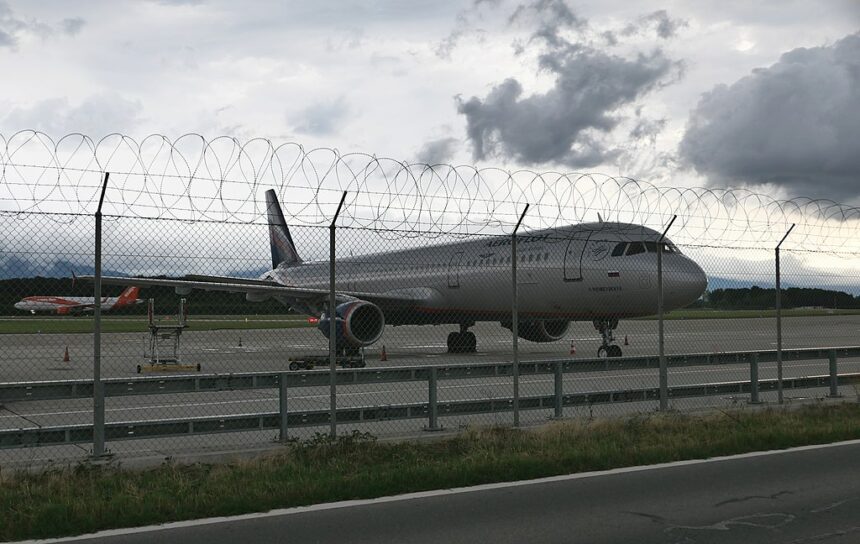Russia’s commercial aviation industry has now faced an extended period of challenges wrought by a shortage of spare parts. This problem, resulting from sanctions imposed following the invasion of Ukraine, has led to a worrying rise in technical malfunctions and safety concerns.
2023 saw a concerning rise in Russian incidents and emergency landings – a tripling of technical malfunctions and incidents was reported.
Analysts predict the situation is likely to worsen in 2024, potentially posing a serious threat to air safety. So will this year see a serious breaking point for Russian commercial aviation?
Sanctions Bite: Restricted Access to Parts and Maintenance
Following the international condemnation of Russia’s actions in Ukraine, a wave of sanctions targeted the country’s aviation sector.
These sanctions restricted Russia’s access to critical spare parts and maintenance services typically obtained from Western manufacturers like Boeing and Airbus.
Western-made aircraft dominate Russia’s commercial fleet, and they are left without access to genuine parts and qualified technicians for these planes.
As a consequence, Russian airlines have been forced to find alternative solutions. These alternatives can be risky and raise safety concerns.

Signs of Trouble: Rise in Malfunctions and Incidents 2023
Several news reports documented a threefold rise in technical malfunctions and incidents involving Russian passenger jets in 2023.
Many of these occurrences are likely linked to the difficulties airlines face in maintaining their aging fleets due to the lack of essential parts.
News source Newsweek revealed a concerning trend of emergency landings in Russia due to what was described as ‘technical issues’.

In the period between September 2023 to early December 2023, there were 60 safety incidents involving aircraft diversions or emergency landings.
This spike in incidents in the latter quarter of 2023 was noticeable, with 15 occurring in September, rising to 25 in October. This dropped slightly to 12 in November, before seeing another surge in December.
While not every incident can be definitively attributed to the parts shortage, the correlation between the sanctions and the rise in problems is a cause for serious concern.

Sanctions, Aging Parts, and Cannibalization
Several factors suggest that the parts shortage problem for Russian airlines is likely to worsen in 2024.
Firstly, there is no indication that the sanctions will be lifted soon. Continued restrictions will make it extremely difficult for Russian airlines to obtain the parts they need.
Secondly, the existing parts on these aircraft will continue to deteriorate with age. As these parts near the end of their lifespan and are not replaced, they become more prone to failure, raising the risk of in-flight problems.
Thirdly, there are fears that Russian airlines may be forced to resort to “cannibalizing” parts from some aircraft to keep others operational.
This involves removing functional parts from one plane to repair another. While this practice might keep a limited number of aircraft flying in the short term, it significantly reduces the overall number of airworthy planes and further compromises safety standards.
Then there is the attendant human factors issue. All major components need to be traced, in order to track their whereabouts and their time to overhaul or replacement.
Robbing components and moving them form aircraft to aircraft increases the risk of human error – mismanagement or mistakes in tracking and maintenance cycles.
The longer the situation draws out, the larger is the potential can of worms. 2023 saw a concerning tripling of incidents. That casts a dark shadow over 2024.

Looking Ahead: A Looming Safety Crisis?
The situation facing Russian airlines is complex and concerning. The combination of persistent sanctions, aging parts, and potential cannibalization of critical components creates a perfect storm that could lead to a significant decline in aviation safety standards.
The longer the situation draws out, the larger is the potential can of worms. 2023 saw a concerning tripling of incidents. That casts a dark shadow over 2024.
While it’s difficult to predict the future with certainty, the current trajectory suggests a challenging year for Russian commercial aviation.
Regulatory bodies and international aviation organizations will likely be closely monitoring the situation and may need to take further action to ensure passenger safety.
Will 2024 be the Tipping Point?
The possibility of 2024 being a tipping point for Russian aviation safety is a very real concern. Here’s why:
- Exponential Growth in Incidents: Incidents tripled in 2023 compared to previous years. This trend suggests a rapid deterioration in safety. This sharp rise indicates that the current situation is unsustainable, and further decline could be catastrophic.
- Compounding Issues: The factors contributing to the problem, like sanctions and aging parts, are not one-time events. They will continue to exert pressure on the system, potentially leading to an exponential increase in malfunctions and accidents.
- Limited Alternatives: Russia explored alternative parts suppliers and attempted to develop domestic replacements. These solutions are unlikely to provide a quick fix. Finding reliable, compatible parts from non-Western sources can be challenging, and developing domestic alternatives typically takes years.
Indicators of a Tipping Point
Several events could signal that 2024 has become a tipping point for Russian aviation safety:
- A Major Accident: A high-profile accident with significant casualties could trigger a public outcry and force international intervention.
- Grounding of Fleets: If airlines are forced to ground a significant portion of their fleets due to a lack of airworthy aircraft, it would be a strong indicator that the system is failing.
- Airline Bankruptcies: Financial strain due to rising maintenance costs and operational disruptions is a warning sign. This could eventually lead to airline bankruptcies, further destabilizing the industry.

Click the banner to subscribe to our weekly newsleter.

Click the photo to join our WhatsApp channel so then you can stay up to date with everything going on in the aviation industry!







